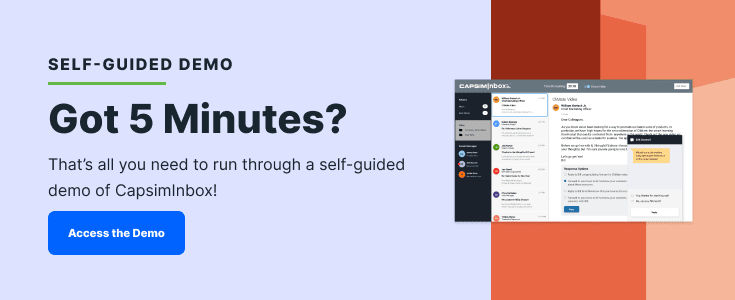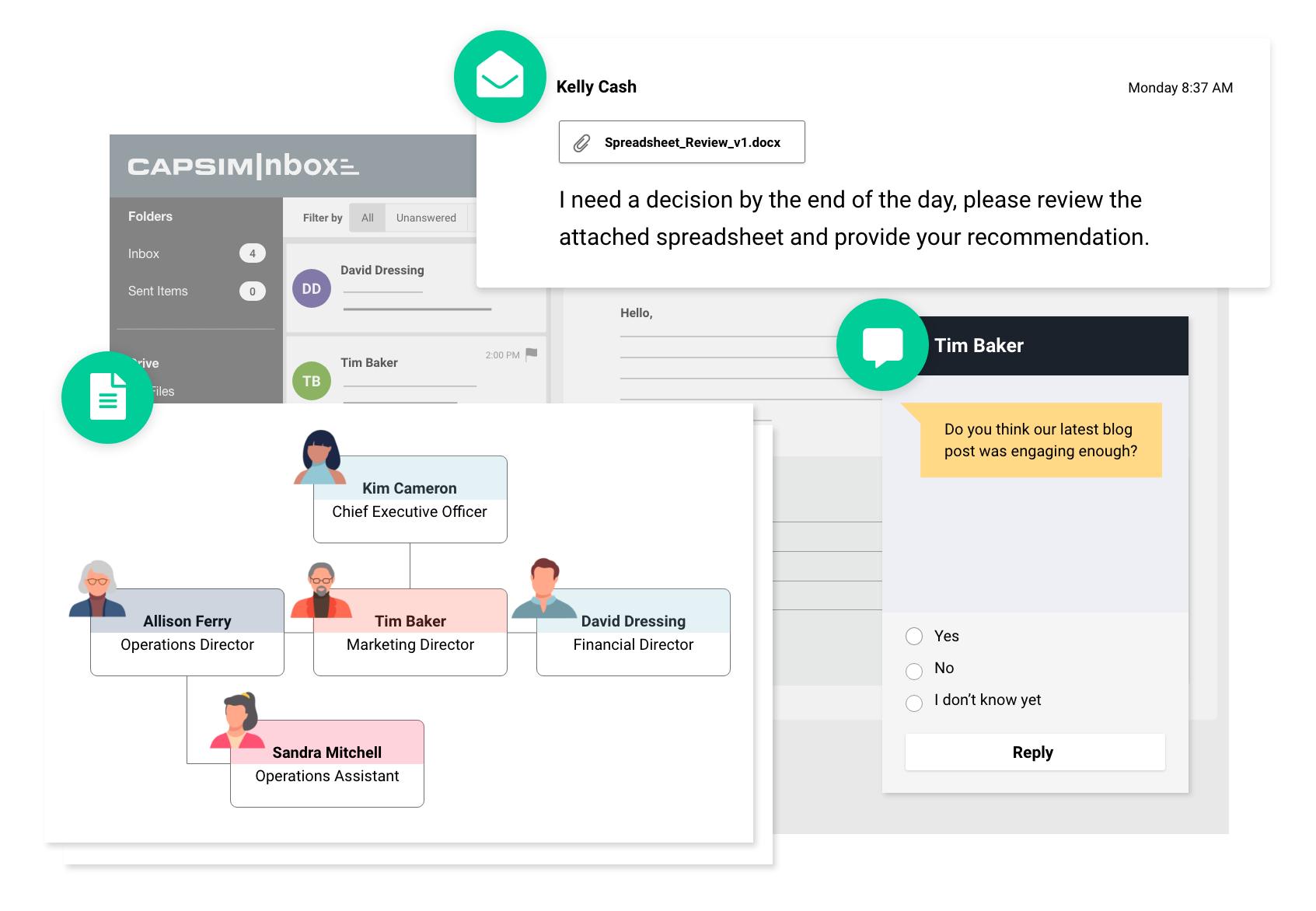How Does Onboarding Improve Employee Performance and Workforce Retention?

July 19, 2022
.jpg)
When it comes to employee onboarding, one day of paperwork, videos, and reviewing the employee handbook doesn’t cut it anymore.
At least not for companies that want stellar performance and low employee turnover.
The Society for Human Resource Management, or SHRM, notes that only 29 percent of employees feel prepared and supported to do a great job in their role.
And when it comes to retention, SHRM found that 69 percent of employees are more likely to stay for at least three years if they experience a great onboarding process.
This article will look at how employee onboarding builds a critical foundation for job performance and employee retention.
We'll also show why inbox simulations are useful as employees onboard and transition into long-term continuous development programs.
4 Ways Employee Onboarding Improves Performance and Retention
Onboarding is the process of integrating new employees into your organization. Think of it like orientation but much more in-depth. Employees will learn about your company's values, mission, and culture.
Some companies spend a couple of days on activities and workshops to provide their onboarding; others spend months getting employees up to speed and embedded into their company.
Employee performance is defined as how an employee fulfills the duties of their role and how they behave in the workplace. Does your onboarding program help them put their best foot forward?
It’s recognized that a quality onboarding process affects employee performance and retention. Why? Without a robust and thorough onboarding process, new employees feel unprepared. And without a culture of support, they might feel undervalued and leave. Replacing lost employees incurs high costs.
Conversely, excellent employee onboarding can improve employee retention by 82 percent.
Yet less than one out of every four organizations onboard well. There’s a huge opportunity here for your company to buck the trend.
An employee should be able to answer three questions after onboarding:
- What is my role?
- Who do I go to for support?
- What does my future look like?
Other questions need answers, but those three are foundational. Let’s dive deeper into how onboarding improves performance and retention.
1. High-Quality Onboarding Helps New Employees Learn The Ropes
Think back to the first time you walked into the office of a new job. Your palms were sweaty, so you didn’t want to shake hands. Then you wondered if your colleagues thought you were stand-off-ish, so you quickly found your desk.
Did you know who your contact at the office was? Who you answered to? Where did you go for answers? And this is all before you even start work! If you didn’t know any of this, chances are you were on the end of poor onboarding that left you feeling vulnerable, disconnected, and with nowhere to turn.
Great onboarding is the crux of your hiring process. It welcomes new employees, helps them get comfortable with teammates, technology, and processes, and connects them to resources that help fill in the blanks.
Great onboarding should be engaging and, above all, helpful. It’s hard coming into a new environment, building relationships with new people, and trying to get up to speed with new processes. Anything you can do to make onboarding seamless and personalized is worth doing. Try thinking outside the box.
For example, at Capsim, we implemented a new initiative where we hand out a helpful guide about our team members on what they can help you with and a fun fact. Evan is our marketing guru, lead communicator, facilitator, and driver in demand generation.
Kelsey's fun fact that helps break the ice is that she was a pastry chef in her past life, and she's now crushing it as a project manager. This can be put into an inbox simulation format to have you "interact" with your new team members before you start your new role.
2. Great Onboarding Sets New Employees Up For Success
The dreaded employee handbook. At best: a comprehensive guide to how your company does things. At worst: a 300-page manifesto that your employees stare at while thinking about what they will have for lunch.
Yes, it’s necessary, but it’s not the best way to set up employees for success. There needs to be as much practical application as possible. People learn processes by doing, taking part, and getting reps in.
Reading a guide on how to use a tool crucial to a business's day-to-day running isn’t going to fill employees with confidence. Having a process that they can follow is better. Best is a process in place, showing examples of the tool in use and identifying when that tool or process should be used.
One possible solution is inbox simulations. In a safe, real-world environment, employees can get up to speed with essential tools and processes without feeling overwhelmed or unprepared.
3. Investing In Employees Early Makes Them Feel Valued
Onboarding isn’t a tick-box exercise. It’s the first real interaction your employees have with your company. You can’t just say, “This is our onboarding process, good luck.” Follow-up is essential.
You need to set goals and benchmarks and clarify what’s expected of them. Will they get regular check-ins with their supervisor or manager in their first ninety days? How will those check-ins work?
Employees will thank you for investing in them, too. Top performers are less likely to go elsewhere if they have a career development plan with your company. And that has to start during onboarding. If you’re not convinced, according to LinkedIn’s 2018 Workforce Learning Report, 93 percent of employees will stay at a company longer if it invests in their careers.
4. A Productive Onboarding Program Provides Support Beyond 90 Days
According to Inc., 20 percent of employee turnover happens in the first 45 days of employment, and 23 percent of new employees turnover before their first anniversary.
After reading this article, you’ll know how vital a robust onboarding program is. You’ll develop an onboarding program that welcomes new hires and provides support for their first ninety days. Good job! But then what?
The first ninety days most likely fly by in a blur of processes and networking. A fruitful relationship between employer and employee requires continuous work on both sides.
Your best bet is to provide every employee with an Individual Development Plan (IDP). An IDP isn’t a one-time activity. It’s an evolving process and partnership between you and your employees. It involves preparation and continuous feedback.
This might include check-ins after six months and a year to ensure a smooth transition and discover how your process might improve.
Increase Employee Performance and Workforce Retention with Inbox Simulations
A well-thought-out onboarding program can make the difference between showing employees you care about their transition to their new role and your employees leaving because they feel overwhelmed and undervalued.
Like any type of learning in the modern workplace, onboarding must be engaging and interactive. CapsimInbox lets your employees engage with real-world scenarios for their role, using micro-sized simulations done digitally from anywhere with an internet connection.
Our simulation tools provide instant feedback and improvement opportunities so your employees can focus on closing their skills gaps and becoming valuable team members.
As part of a more significant learning and development effort and for creating an IDP, CapsimInbox is a valuable and beneficial tool. Our technology supports and guides your efforts for a truly immersive experience.
To find out how CapsimInbox works, try our Self-Guided Demo today!





.png?width=80&name=1-questions%20(1).png)